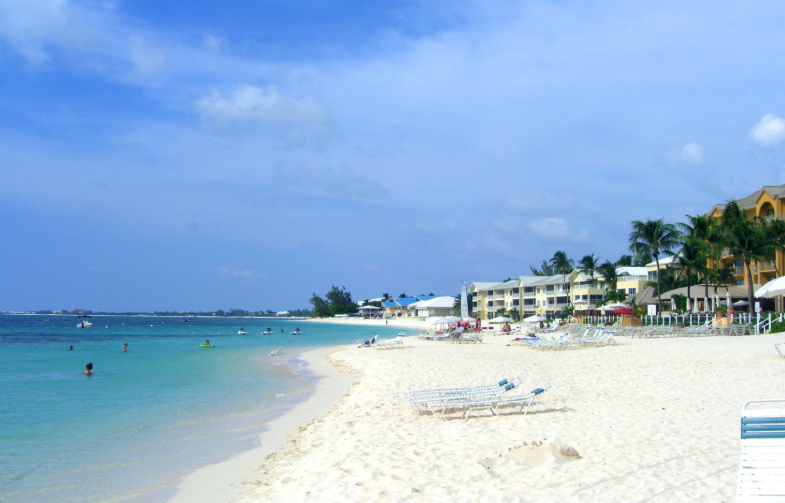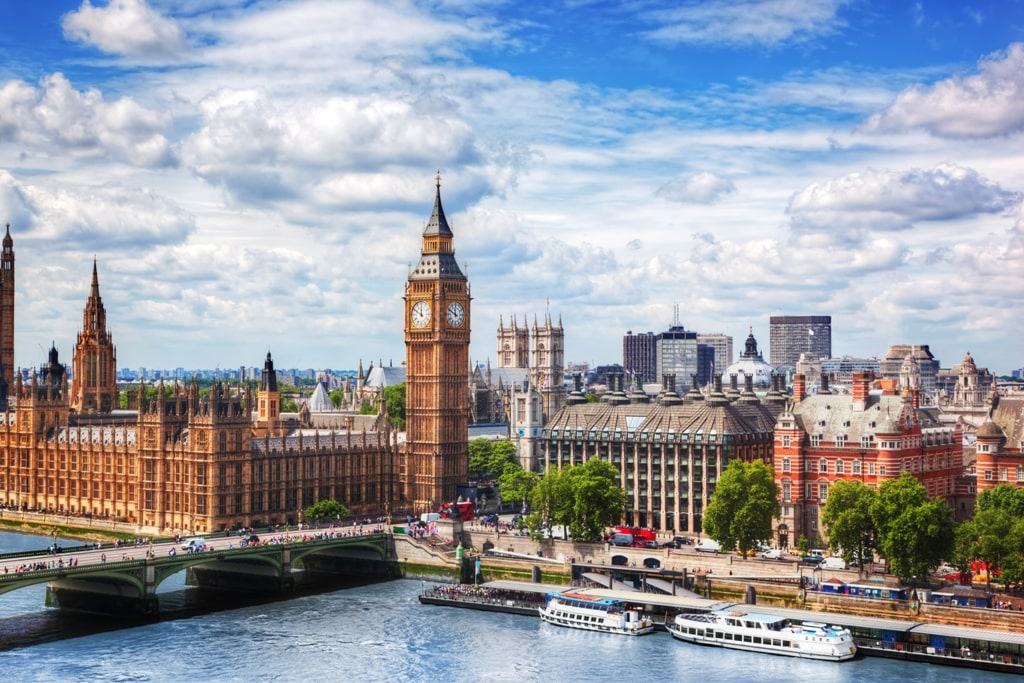
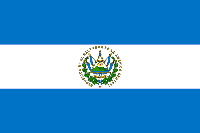
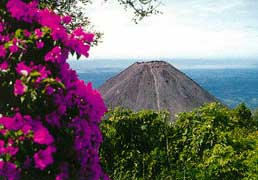

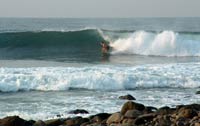
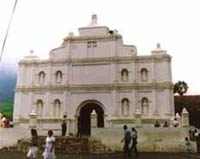

Does the term ‘El Salvador’ make you uneasy? Some are overcome with a negative feeling when hearing the words, associating it with the civil war that occurred there in the 1980’s. Many are surprised to learn that today’s El Salvador is actually an alluring and rewarding place to visit. The country is in peace. The only chilling feature it touts is its volcanoes. Only three months ago, Santa Ana Volcano erupted after 100 years in dormancy, only forty miles from the city of San Salvador. The remainder of the country is not threatening, but instead, quite thrilling to explore.
The history of El Salvador reaches back centuries, nonetheless, its spirit remains imbedded in the culture of the country and its people today. This spirit is demonstrated in structures such as the Olmec Boulder. The rock sits in the form of a giant head. This figure provides proof of the presence of the Olmec people as far back as 2000 BC. The Maya society also had a presence in El Salvador, signified by the step-pyramid ruins in Tazumla and San Andres. It is believed that they were in the country for over 1000 years. There is evidence that other cultures such as the Chorti, Lenca, and Pokomam found home in El Salvador during its early years also. The Pipil people, descendents of the well-known Aztecs, arrived in the country in the 11th century. The Pipil lived like that of the Aztecs, with a sophisticated agricultural system. They were also experts in astronomy, mathematics, and hieroglyphic writing. This developed community remained through the 16th century, until the Spanish arrived. The Spanish conquistador Pedro de Alvarado arrived in 1525, and led the new community in the development of cotton plantations, indigo and balsam. Like so many other Spanish conquered countries, the indigenous people, along with Africans, were made slaves on the fields. After numerous rebellions against the Spanish in the 1800’s, and Napoleon’s invasion of Spain, El Salvador gained independence as an autonomous nation.
Then, as a result of the invention of synthetic dyes in the late 1800’s, the indigo market crashed and the coffee industry took over as El Salvador’s main economic base. In the 1900’s only two percent of the population controlled the substantial wealth generated by the coffee industry, which equaled about 95 percent of the country’s income. Civil war was jump-started by this imbalance in wealth, as early as the 1920’s. Over the years the country struggled with constant civil war and strife amongst its people. It wasn’t until 1992 that a cease-fire was established, supported by the United Nations and their mediated negotiations with the opposition party, FMLN. Today, El Salvador has a high unemployment rate, significant poverty, and restless ex-combatants. Nevertheless, just a peak at photographs of the country’s landscape can stimulate waves of curiosity in the adventurous traveler. Tourism in El Salvador is booming. Interesting and active adventure packages can be found in abundance on the Internet.
Where to Go and What to Do
The capitol city of El Salvador has an intriguing locale at the base of the San Salvador Volcano, which last erupted in 1917. It may sound picturesque, but the outrageous pollution makes the city more of an assault of the senses. There are shantytowns throughout the city, and street merchants trying to sell an abundance of items. Still, the city holds some intriguing historic attractions. The Teatro Nacional is a cultural icon in San Salvador. Built starting in 1917, the theatre is popular for its lush mural covering the ceiling and flowing into the adjacent Teatro Café, which, quite sensuous itself, is adorned in red velvet. For handicrafts, visit Mercado Ex-Cuartel. Its here travelers can find ceramics and other handmade items.
El Salvador was a religious center in its early stages of settlement. Today, the structures built for worship still stand proud and tell the story of the region’s personality. Art enthusiasts revel in the classic and baroque styles of the buildings, namely Candelaira Church, Metapan Church, and San Vicente, among others. Santa Ana has a fantastic sampling of these religious icons, including a Cathedral decorated in colonial European-like richness. The oldest church in the country, The Church at Panchimalco, is located in its namesake town, near San Salvador.
When you’re ready for a breath of fresh air, head for the hills, where there is an abundance of sites to see. Alegria is one of El Salvador’s jewels. The town is a haven for growing flowers, with over 230 different buds accenting yards and homes throughout the area. The stunning aquamarine Alegria Lagoon waits within the Tecapa Volcano crater. The Pipil descendants come from Alegria. Find a local chieftain to tell the stories of the town’s legends.
The El Salvadorian countryside is diverse in ecology, and has a mysterious geology. A high percentage of the land is mountainous, with over 25 inactive volcanoes. Exploring the dormant volcanoes, Santa Ana, Izalco, or San Miguel, travelers will have the opportunity to see large craters filled with petrified lava from years past. Each volcano has a life story. Izalco’s nickname is “Lighthouse of the Pacific”, because it was used to guide ships into shore with it’s glowing lava and steam. At 7,804 feet, Santa Ana, also called Lamatepec, stands the tallest of the volcanoes of El Salvador. A true adventure waits at Cerro Verde Volcano National Park, located west of San Salvador. Energetic souls can take a hike to the top of the volcano. From high, there are outstanding views of the Coatepeque Lake, Izalco Volcano and the Pacific Ocean.
Rivers flow plentiful in El Salvador. They originate in Guatemala and make their way through different climates in the country. There is the Rio Grande, Torola, Paz, and Jiboa, just to name a few. The waters of these rivers make their way through El Salvador and into the Pacific Ocean. The Rio Paz offers stirring white water rafting. There are level 2-3 rapids in the Las Urracas section of the river. Clean waters, waterfalls, river ponds, and unforgettable water jumps provide memorable experiences for those that dare take on the rapids.
The confident rivers of El Salvador give life to the magnificent lakes of the country. They are simply breathtaking. Consider visits to Coatepeque, located in the Department of Santa Ana and Guija, or Ilopango, just nine miles from the city of San Salvador. Coatepeque may be one of the most breathtaking lakes in the entire world. The lake was made from two volcanic eruptions that occurred more than 50,000 years ago.
The beaches of El Salvador serve as the doorway to the country’s oceanic beauty, and its surfing haven. The Litoral Highway was built connecting the East and West Coast of El Salvador. The road makes for easy access to the shorelines of El Salvador. To the south, the Pacific Ocean lends warm water to the water sports enthusiast. In fact, there are plenty of coastlines to share, 184 miles to be exact. The Pacific coastline of El Salvador is known for its beauty and warmth, and is visited by tourists from all around the world. Its characteristics are not like a typical Caribbean beach. There are impressive rock figures and cliffs dotting the shores. The scenery is made even more unique by its lush tropical vegetation covering the stones. Along the Pacific Coast, consider a stop at La Barra de Santiago in the Department of Ahuachapan, or El Tamarindo in the Department of La Union. If you are searching for beaches that accommodate visitors, Metalio, Playa Dorada, and Los Cobanos are fantastic choices. They maintain upscale private beach clubs and gorgeous recreational centers. Water sports central is at San Diego and Costa del Sol, only 40 minutes from San Salvador. If the East Coast beckons, visit the reputable Gulf of Fonseca or the popular El Espino beach.
For people interested in flora and fauna, El Salvador will be alluring also. The vegetation of the area differs through the various ecological zones of the regions. The land’s native vegetation has been diminished due to human intervention. Today, many areas where forests once stood are now agricultural in nature and yield cotton, sugar cane, or coffee. Although El Salvador does not have the typical Caribbean flora, due to its distance from the Caribbean Sea, it still has vibrant vegetation, including over 200 orchid species. Balsam woods are also very prevalent around the swamplands.
Human consumption has also threatened the animal of El Salvador. Some have even been made extinct, including the crested eagle and the jaguar. There are, however, areas that have been established as environmental reserves to help keep alive the undamaged flora and fauna existing there. These preserves have sincerely helped. Today, there are 17 hummingbird species and possibly 400 bird species, as well as many small animals thriving, thanks to these reserves. Most protected areas have been established as parks and can be explored. They include Cerro Verde Mountain Park, Walter Deininger Park, El Trifinio, Jocotal Lagon, Montecristo, and El Imposible Forest. Trek through rain forest in Montecristo and experience a wide variety of flora and fauna. Cloud forest thrives in Montecristo, boasting old, tall laurel and oak trees. El Imposible is a forest reserve in the mountains and the largest protected area in the country. The park is located in Ahuachapan, 70 miles west of San Salvador. There is an interpretive trail in the park that helps visitors understand the history and delicate eco-system of the park. The park has an eco-lodge and restaurant. Further into the park, there are many timeless treasures. Ancient engravings adorn sealed rocks, while coves with crystal clear waters await bathers.
Other opportunities for recreation and adventure exist in any of the fourteen visitor centers in the central mountain range, Pacific Coastline, and other areas throughout the country. If a more strenuous or challenging adventure is what you are looking for, get to the Morazan Mountains. There is tremendous hiking and rappelling there.
Accommodations
Average hotel room prices range from 5 US dollars to over 35 US dollars for deluxe accommodations.
There are some interesting hotels in El Salvador. Casa de Mar Resort is a 4-star boutique resort located in Playa Sunzal. The hotel is a fairly new building, opened in September of 2004. There are eleven suites, each one different than the other. All of the rooms have hot water, air conditioning, a private deck, living room, dining room, and private bathroom. The resort itself has an irresistible seafood restaurant, Café Sunzal. Other amenities include a swimming pool, Internet access, and beach access. The resort also rents kayaks and surfboards. Perhaps the best part about the resort is that it is situated right on the point of Sunzal.
The Las Flores Surf Club is an architectural treat. Located at Las Flores point in El Cuco on a gorgeous isolated beach, the hotel is a surfer’s dream. The facility is managed by surfers, and is situated on the coast where huge waves form, 200m and larger. La Flores sets itself apart in many ways, but one of their best attributes is their effort at creating sustainable tourism. The resort only allows 16 guests at a time, per week. They offer boat trips to access the best breaks off the coast, carrying only eight surfers, per trip. Fortunately, the resort welcomes non-surfers also.
For a place to retreat in the city consider the Novo Hotel in the heart of San Salvador. It’s near restaurants, nightlife, and shopping malls. There are fifty relaxed apartments with kitchenettes. On property, the hotel has a swimming pool, a superb restaurant, and a comfortable grassy courtyard. The room rate includes a breakfast buffet each morning. This hotel is recommended specifically for its service standards.
There are many options for dining in El Salvador. Some of the best restaurants are located at the resorts. Seafood is, of course, a prime option in the country. When budgeting, keep in mind that average meal prices range from 3 US dollars up to 20 US dollars.
Climate
The climate of El Salvador is typical of Central America. Temperatures soar between 87-89 degrees Fahrenheit throughout the year, and drop to the high teens during the night. Precipitation varies around the country. An annual average of 80 inches is normal where Guatemala, Honduras and El Salvador meet. January and February are the driest months.
Getting There
Getting to El Salvador is a cinch for American, Canadian, and Western European citizens. A visa is not required. These visitors must only buy a tourist card upon entering the country, which is valid for 90 days. All other voyagers need to obtain a visa before entering.
Flights to and from major US cities are plentiful. Major airlines stop in Atlanta, Dallas, Houston, Los Angeles, Miami, New York, and San Francisco. Taca is El Salvador’s national airline, and Comalapa International Airport is located just 27 miles south of San Salvador. From the airport, catch a taxi or van up to San Salvador. There is a highway between the airport and the city that is in good condition.
In addition to the fairly recent volcanic eruption, Hurricane Stan enveloped El Salvador with heavy rain, causing flooding and landslides throughout the country. Any visitors to the country should find out the latest conditions and if travel is advisable.
Blue Diver is a tour operator dedicated to making your vacation in El Salvador unforgettable. The company is highlighted on Tropical-Adventure.com. To locate Blue Diver, first visit Tropical-Adventure.com. From the home page, find the Central American/El Salvador page via the ‘Quick Adventure Search’ tool. This link will take you right to a link to Blue Diver, and an opportunity to take a unique and invaluable vacation in El Salvador.
Resources
Accommodations
Casa De Mar Hotel And Villas At Sunzal
La Libertad
Telephone: (503) 2389-6284
Playa Las Flores
San Miguel
Telephone: (503) 2619-9065
Novo Hotel
San Salvador
Telephone: (888) 703 5327
Get More Information on This Adventure!!!
Experience adventures like the one found in this article and others by using TropicalAdventure.com Vacation Planner. Simply fill out our Vacation Planner form and you will receive FREE information about this activity and others that you may be interested in. Click below to sign up.

